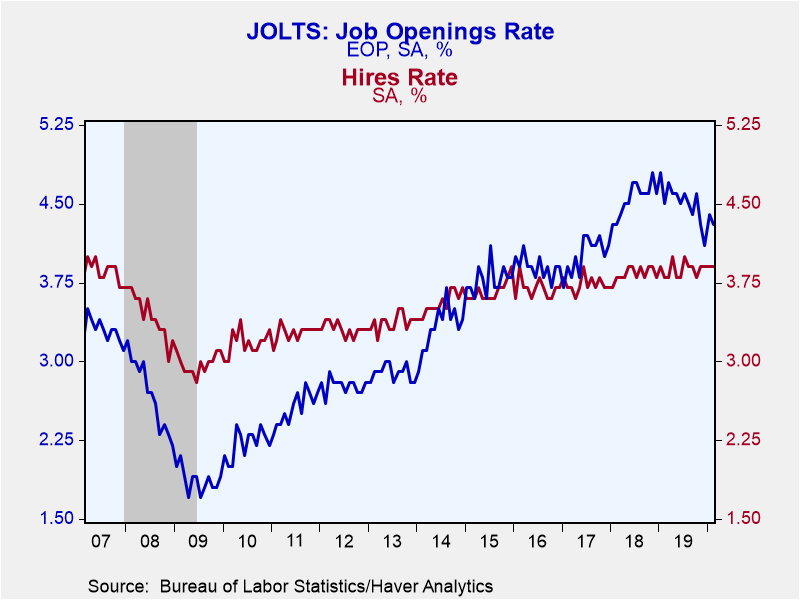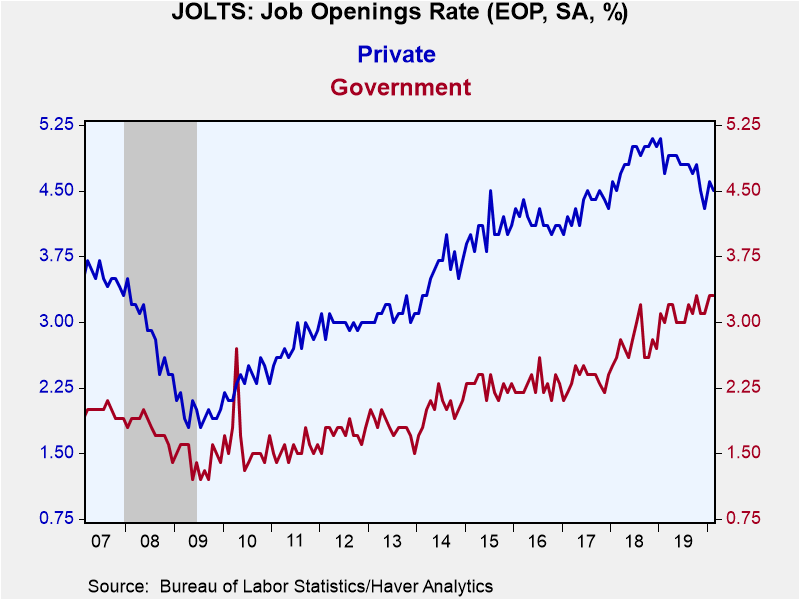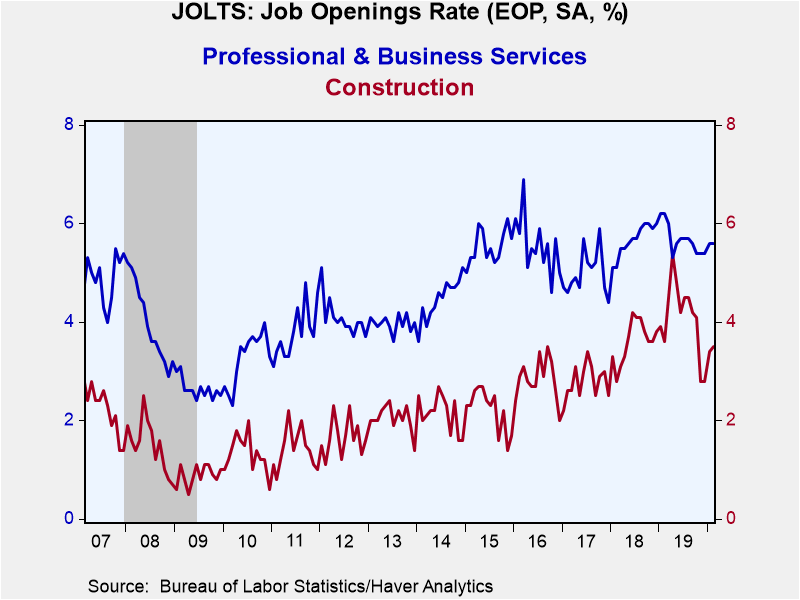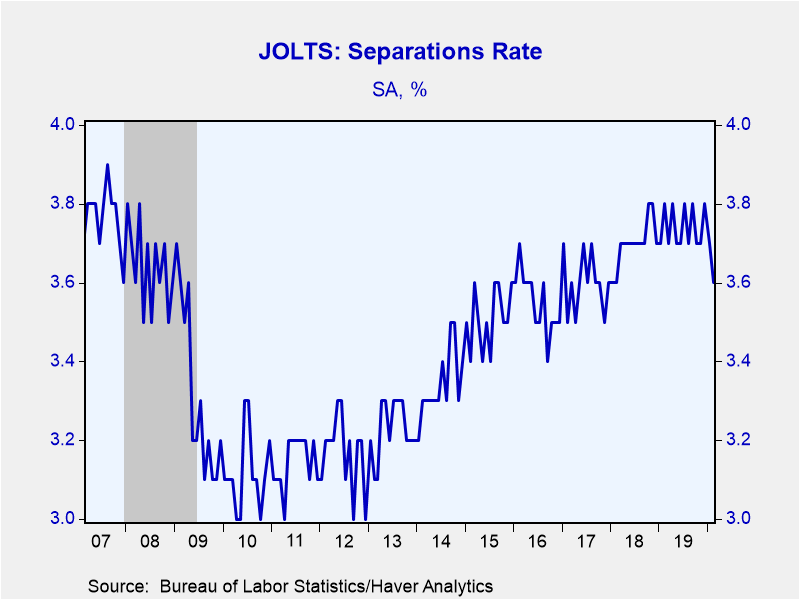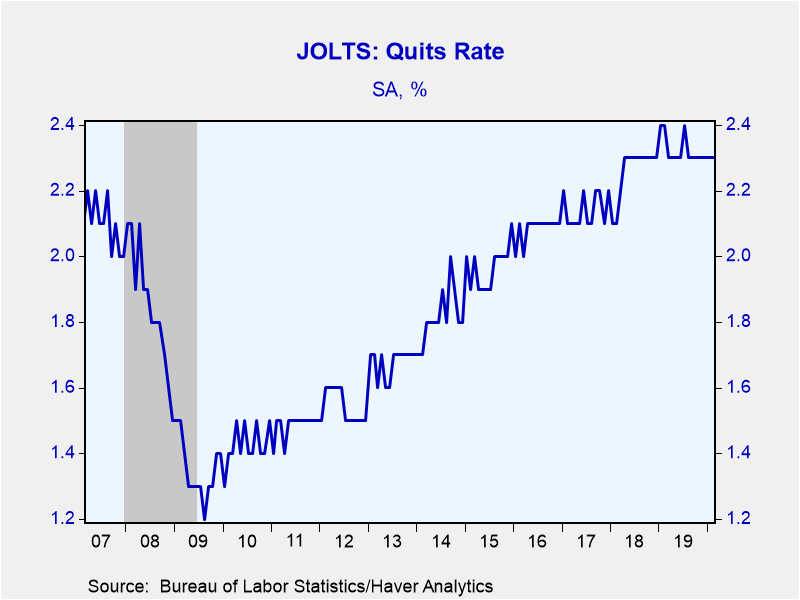 Global| Apr 07 2020
Global| Apr 07 2020U.S. JOLTS: Job Openings Ease
by:Tom Moeller
|in:Economy in Brief
Summary
The Bureau of Labor Statistics reported that total the job openings rate slipped to 4.3% during February from 4.4% in January. The rate is openings as a percent of total employment plus openings. These figures remained below the 4.8% [...]
The Bureau of Labor Statistics reported that total the job openings rate slipped to 4.3% during February from 4.4% in January. The rate is openings as a percent of total employment plus openings. These figures remained below the 4.8% record reached in January 2019. The hiring rate held steady at 3.9% in February and remained near it expansion high of 4.0% reached last July. The layoff and discharge rate rose to 1.2% in February, up from 1.1% which equaled the lowest point on record. The quit rate was unchanged at 2.3% and remained slightly below the highest rate of the expansion.
On the last business day of February, the job openings level totaled 6.882 million, down 2.4% y/y. The number of job openings fell 2.1% m/m (-3.8% y/y) for total private but edged 0.1% higher (11.1% y/y) for government. Job openings fell 9.1% y/y in manufacturing but rose 3.7% y/y in health & human services. The number of job openings fell 7.4% y/y in leisure & hospitality and declined 9.0% y/y in professional & business services.
The private-sector job openings rate declined to 4.3% from a downwardly revised 4.4% in January. The record rate is 5.1% reached in January 2019. The construction sector's job openings rate of 3.5% compared to 5.4% at its peak in April of last year. The rate in manufacturing was 3.2%. On the high side, the rate in leisure & hospitality held at 5.2% and was steady at 5.6% in professional & business services. The government sector job openings rate was unchanged at a record 3.3%.
In February, the level of hiring rose 3.4% to 5.896 million with the hiring rate steady at 3.9%. Private sector hiring rose 3.2% y/y while government hiring jumped 6.4% y/y. Hiring in construction rose 14.6% y/y, but was unchanged y/y in the factory sector. Leisure & hospitality hiring rose 1.9% y/y but it fell 7.6% y/y in professional & business services.
The total separations rate declined to a two-year low of 3.6% as the level of separations declined 2.0% y/y. The separations rate in the private sector fell to 4.0% and was 1.5% in government. The rate was 6.1% in leisure & hospitality, the lowest since December 2017. Professional & business realized a 4.8% rate, the lowest since December 2014. In education & health services the rate was 2.8%.
The layoff & discharge rate in the private sector rose to 1.3% while it was stable at 0.4% in government. The rate of 2.7% in construction compared to 0.9% in manufacturing. The 1.0% rate in the information sector was near the 0.6% rate in finance. The professional & business services layoff & discharge rate fell to 1.6%, the lowest since April 2018.
The quits rate held steady at an elevated 2.3%. The private sector quits rate of 2.5% compared to 0.8% in government. The level of job quits in the private sector fell 1.5% y/y but rose 3.8% y/y in government. In manufacturing, the level of job quits declined 7.7% y/y but it rose by one-quarter y/y in finance. The number of quit in professional & business services declined 2.2% y/y and fell 9.7% y/y in leisure & hospitality.
The Job Openings and Labor Turnover Survey (JOLTS) dates to December 2000; the figures are available in Haver's USECON database.
News Sentiment in the Time of COVID-19 from the Federal Reserve Bank of San Francisco is available here.
| JOLTS (Job Openings & Labor Turnover Survey, SA) | Feb | Jan | Dec | Feb'19 | Feb'18 | Feb'17 |
|---|---|---|---|---|---|---|
| Job Openings, Total | ||||||
| Rate (%) | 4.3 | 4.4 | 4.1 | 4.5 | 4.3 | 3.9 |
| Total (000s) | 6,882 | 6,963 | 6,552 | 7,048 | 6,575 | 5,872 |
| Hires, Total | ||||||
| Rate (%) | 3.9 | 3.9 | 3.9 | 3.8 | 3.8 | 3.7 |
| Total (000s) | 5,896 | 5,925 | 5,927 | 5,703 | 5,669 | 5,366 |
| Layoffs & Discharges, Total | ||||||
| Rate (%) | 1.2 | 1.1 | 1.2 | 1.2 | 1.2 | 1.2 |
| Total (000s) | 1,755 | 1,741 | 1,893 | 1,791 | 1,781 | 1,698 |
| Quits, Total | ||||||
| Rate (%) | 2.3 | 2.3 | 2.3 | 2.4 | 2.1 | 2.1 |
| Total (000s) | 3,497 | 3,574 | 3,528 | 3,541 | 3,175 | 3,081 |
Tom Moeller
AuthorMore in Author Profile »Prior to joining Haver Analytics in 2000, Mr. Moeller worked as the Economist at Chancellor Capital Management from 1985 to 1999. There, he developed comprehensive economic forecasts and interpreted economic data for equity and fixed income portfolio managers. Also at Chancellor, Mr. Moeller worked as an equity analyst and was responsible for researching and rating companies in the economically sensitive automobile and housing industries for investment in Chancellor’s equity portfolio. Prior to joining Chancellor, Mr. Moeller was an Economist at Citibank from 1979 to 1984. He also analyzed pricing behavior in the metals industry for the Council on Wage and Price Stability in Washington, D.C. In 1999, Mr. Moeller received the award for most accurate forecast from the Forecasters' Club of New York. From 1990 to 1992 he was President of the New York Association for Business Economists. Mr. Moeller earned an M.B.A. in Finance from Fordham University, where he graduated in 1987. He holds a Bachelor of Arts in Economics from George Washington University.


